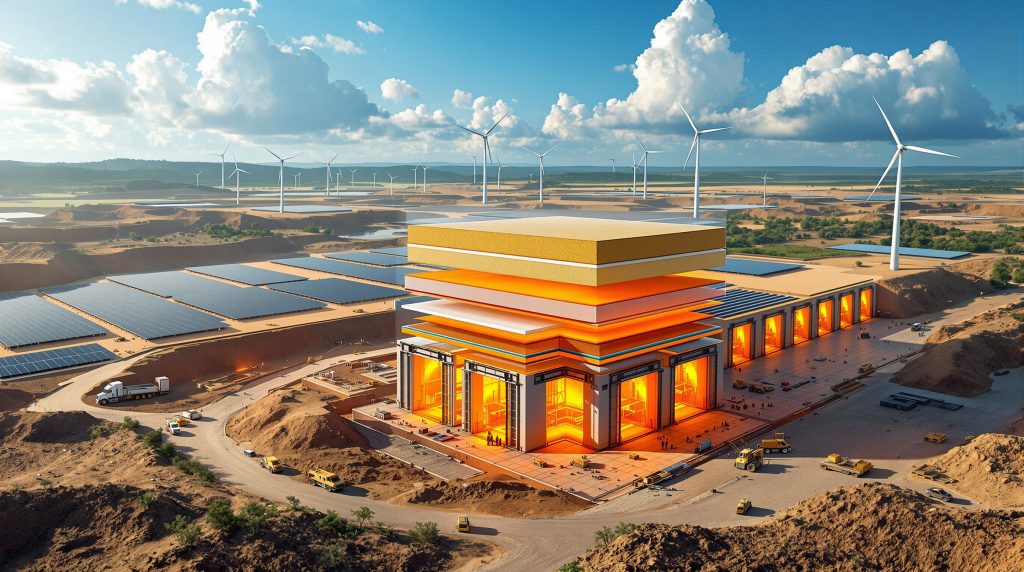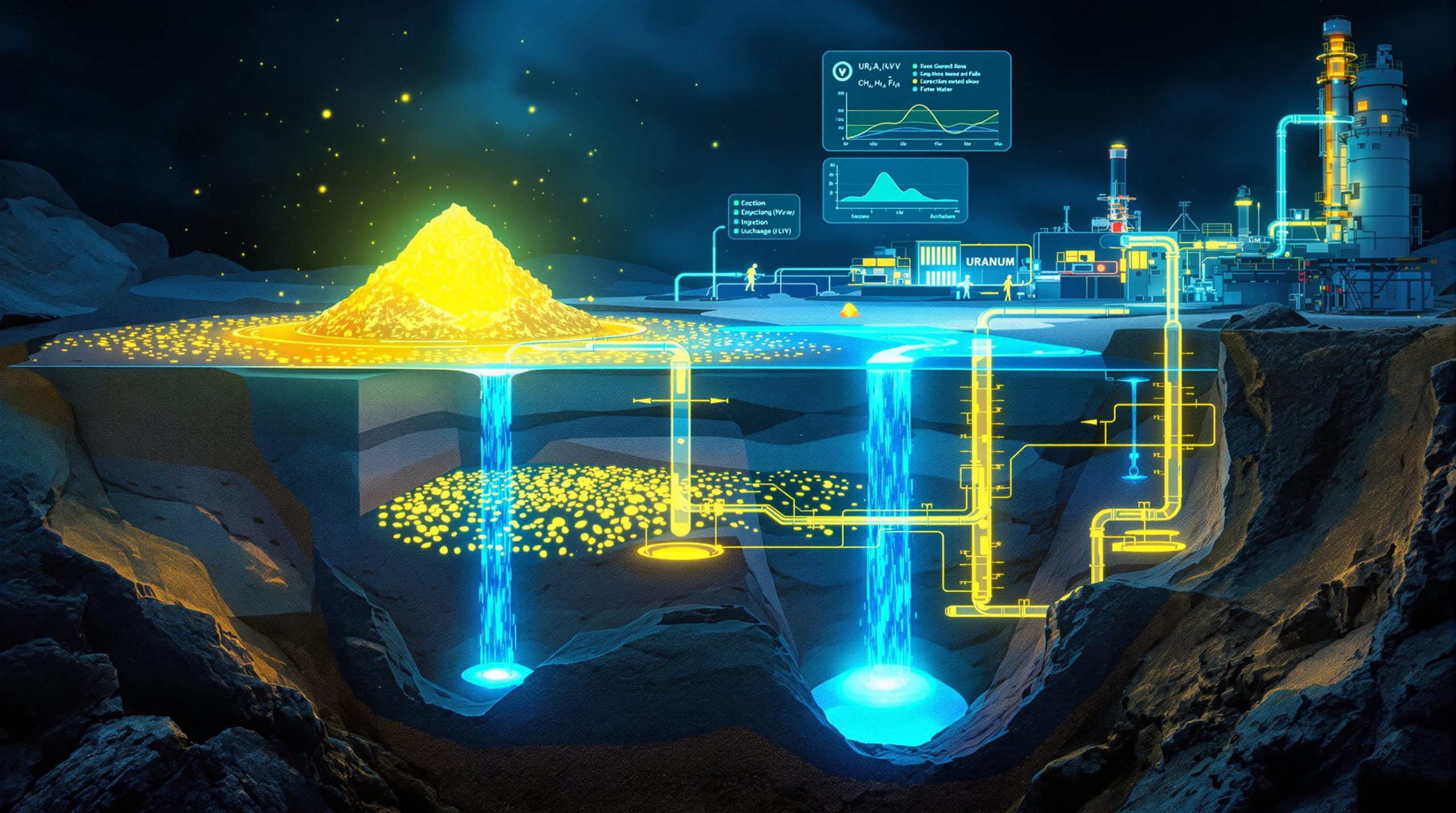The Hidden Giants: How Sand and Gravel Power the Clean Energy Revolution
When discussing critical minerals for the clean energy transition, most attention focuses on lithium, cobalt, and rare earth elements. However, research from the University of Queensland's Sustainable Minerals Institute reveals a surprising fact: construction aggregates like sand, gravel, and limestone comprise approximately 70% of the mineral requirements for renewable energy infrastructure by volume.
These seemingly mundane materials form the literal foundation upon which our green energy future is being built, serving as the backbone for everything from wind turbine bases to hydroelectric dams.
Beyond Rare Metals: The Foundation of Clean Energy
While the World Bank identifies 17 minerals crucial for renewable energy technologies, construction aggregates far outweigh all others in terms of volume requirements. These materials are essential components of concrete used in renewable energy infrastructure, providing the structural stability necessary for long-term operation.
According to the U.S. Geological Survey, a typical wind turbine foundation requires between 400-2,000 cubic yards of concrete, depending on turbine size and soil conditions. For a standard 2-3 MW turbine, foundations typically use 1,000-1,500 cubic yards of concrete, equivalent to approximately 120-180 dump truck loads.
The global production of sand and gravel reached approximately 50 billion tonnes annually as of 2019, making it the second-most extracted resource after water, according to the United Nations Environment Programme.
The Scale of Demand in Numbers
Standard concrete mixes for renewable energy infrastructure consist of:
- 60-75% aggregate (sand and gravel combined)
- 10-15% cement (derived from limestone)
- 15-20% water
- 5-8% air and admixtures
For large-scale renewable projects, the numbers are staggering. Utility-scale solar installations require significant concrete for mounting structure foundations. A typical 100 MW solar farm uses approximately 40,000-60,000 cubic meters of concrete for tracker foundations and inverter pads.
Why Is Sand So Crucial for the Energy Transition?
The Overlooked Backbone of Renewable Infrastructure
Sand and gravel serve as the primary components in concrete, which provides the structural stability for:
- Wind turbine foundations (requiring 200-800 tonnes of concrete per turbine)
- Solar panel mounting systems and support structures
- Hydroelectric dam construction
- Pumped hydro energy storage facilities
- Transmission infrastructure foundations
Modern offshore wind turbines with 8-15 MW capacity require gravity-based foundations using 50,000-60,000 cubic meters of concrete, equivalent to approximately 120,000-144,000 tonnes of aggregate materials.
Engineering studies demonstrate that wind turbine foundations must withstand dynamic loads including wind thrust, blade rotation moments, and fatigue cycles over 20-30 year operational lifespans. The mining industry evolution has been crucial in developing techniques to extract these materials efficiently.
Comparative Resource Requirements
When comparing mineral needs across different renewable technologies:
| Material Type | Percentage of Total Mineral Demand for Clean Energy | Primary Applications |
|---|---|---|
| Sand, Gravel & Limestone | ~70% | Concrete for foundations and structures |
| Iron/Steel | ~15-20% | Structural components, towers, reinforcement |
| Aluminum | ~3-5% | Transmission, solar frames, lightweight components |
| Copper | ~2-3% | Electrical systems, generators, transmission |
| Critical Minerals (Li, Co, REEs) | ~1-2% | Batteries, magnets, specialized components |
Not all sand is suitable for construction applications. Construction-grade sand must meet specific criteria:
- Particle size distribution: typically 0.15-4.75mm
- Low clay and silt content (<3%)
- Angular particles for mechanical interlock
- Proper gradation per ASTM C33 standards
Desert sand and most marine sand fail these requirements due to particle rounding and/or excessive salt content, creating sourcing challenges for the renewable energy sector.
How Does Sand Mining Impact the Environment?
Environmental Challenges of Aggregate Extraction
Despite their critical importance, the extraction of sand and gravel creates significant environmental impacts that are often overlooked in sustainability assessments:
- Habitat destruction in river systems and coastal areas
- Landscape fragmentation from quarrying operations
- Water quality degradation through increased turbidity
- Disruption of aquatic ecosystems and biodiversity loss
- Groundwater table alterations affecting local hydrology
The United Nations Environment Programme estimates that between 40-50 billion tonnes of sand and gravel are extracted globally each year, exceeding natural renewal rates in many regions.
Research in the Mekong River basin documented that sand mining operations caused channel incision of 1-2 meters and bank erosion extending 50-100 meters inland in heavily extracted areas over a 10-year period.
Sustainability Concerns
Environmental scientists have documented that riverbed sand extraction can trigger cascading ecological impacts including altered sediment transport, modified river morphology, reduced floodplain connectivity, and diminished spawning habitat for fish species. These impacts can extend kilometers downstream from extraction sites.
Studies of marine sand extraction operations show that dredging activities increase water turbidity by 10-100 fold within 100-500 meters of operations, affecting photosynthesis in seagrass beds and filter-feeding behavior in shellfish.
Quarry operations below the water table can create cone-shaped depression zones extending 2-5 times the quarry radius, depending on aquifer properties. Drawdown of 3-10 meters has been documented within 1 kilometer of active operations.
The perception of sand as an abundant, low-value resource has led to inadequate monitoring and regulation of extraction activities. This oversight is problematic as research shows that unsustainable sand mining practices can cause long-term ecological damage that may undermine the environmental benefits of renewable energy deployment.
Can Former Mining Sites Support Clean Energy Generation?
Repurposing Extraction Sites for Renewable Energy
An emerging trend involves transforming depleted sand and gravel quarries into sites for renewable energy generation:
- Solar farms installed on reclaimed quarry land
- Wind turbines positioned on elevated areas of former extraction sites
- Pumped hydro facilities utilizing the topography of abandoned quarries
- Combined energy generation and storage systems that maximize land use
A study of 47 rehabilitated quarry sites in the United Kingdom found that 34% were converted to water bodies, 23% to nature reserves, 15% to recreational facilities, and 11% to industrial/commercial uses, with renewable energy projects representing an emerging category.
Case Study: Brownfield-to-Green Transformation
The Sunshine Valley Solar Farm in Nevada represents a successful conversion of former mining land into renewable energy production. Developed on 600 acres of previously disturbed land, this 50 MW solar facility demonstrates how extractive industries can transition to sustainable energy generation.
Former quarry sites offer several technical advantages for solar development:
- Pre-cleared land requiring minimal vegetation removal
- Often flat or graded surfaces suitable for panel installation
- Existing access roads and electrical infrastructure in some cases
- Typically removed from residential areas, reducing community opposition
- Lower land acquisition costs compared to agricultural or forested land
Urban planning research indicates that former quarry sites can achieve successful conversion to productive uses when strategic planning addresses key challenges: soil contamination remediation, slope stabilization, groundwater management, and infrastructure access. Solar installations are particularly suitable due to lower soil quality requirements. Furthermore, mine reclamation innovations continue to improve the viability of these sites.
What Innovative Energy Storage Technologies Use Sand and Gravel?
Gravity-Based Energy Storage Systems
Beyond their use in construction, sand and gravel are being explored as physical media for energy storage technologies:
- Mountain Gravity Energy Storage (MGES) systems use excess renewable electricity to lift sand or gravel to higher elevations
- When energy is needed, the material is lowered, turning generators to produce electricity
- These systems can be deployed in 1-20 MW capacities, making them suitable for smaller communities or island locations
- Unlike pumped hydro, MGES can operate in areas with limited water resources
Research modeling suggests MGES systems could achieve round-trip efficiency of 80-90% with energy storage costs potentially as low as $50-100/MWh for long-duration (8+ hour) storage applications.
Engineering analyses indicate that gravity-based storage systems using sand or gravel as the working mass can be deployed at scales from 1-100 MW, with particular suitability for microgrids and island communities where pumped hydro is geographically infeasible. The technology requires minimal water resources, addressing a key limitation of conventional storage.
Mountain Gravity Energy Storage systems typically consist of:
- Elevated storage location (mountain top or artificial hill)
- Cable system for raising/lowering mass
- Motor-generator unit (reversible)
- Control systems for charge/discharge optimization
- Typical head height: 200-1000 meters
- Mass requirements: 5,000-20,000 tonnes per MW of capacity
Thermal Energy Storage in Sand
Sand-based thermal batteries represent another innovative application:
- Sand can be heated to temperatures exceeding 500°C using surplus renewable electricity
- The stored heat remains available for months with minimal loss
- This thermal energy can be retrieved for district heating or industrial processes
- Commercial sand battery systems are already operational in Finland, providing heating during cold winter months
The Polar Night Energy sand battery installation in Kankaanpää, Finland, stores 8 MWh of thermal energy at temperatures up to 500-600°C with reported heat retention for months. The system uses approximately 100 tonnes of sand as the storage medium.
Materials science research demonstrates that while sand has lower thermal capacity (specific heat 0.8 kJ/kg·K) compared to materials like molten salt (1.5 kJ/kg·K), sand's advantages include low cost ($10-30 per tonne), thermal stability to 1000°C+, no chemical degradation, and no freezing risk.
Thermal energy from sand batteries can be extracted through:
- Air circulation heat exchange systems
- Integration with district heating networks
- Industrial process heat applications (100-500°C)
- Combined heat and power configurations
How Do Sand-Based Energy Solutions Compare to Alternatives?
Efficiency and Performance Metrics
While sand offers advantages for certain energy applications, its performance characteristics vary compared to alternative materials:
| Storage Medium | Thermal Capacity | Cost Efficiency | Deployment Flexibility | Maintenance Requirements |
|---|---|---|---|---|
| Sand | Moderate | High | High | Low |
| Clay | High (3x sand) | Moderate | Moderate | Moderate |
| Molten Salt | Very High | Low | Low | High |
| Water (Pumped Hydro) | N/A (mechanical) | Moderate | Low | Moderate |
Material-specific thermal energy storage capacities:
- Sand (silicon dioxide): 0.8-0.84 kJ/kg·K
- Clay minerals: 0.9-1.0 kJ/kg·K
- Molten salt (sodium nitrate): 1.5-1.6 kJ/kg·K
- Water: 4.18 kJ/kg·K (not suitable for high-temperature storage)
- Concrete: 0.88-1.0 kJ/kg·K
Practical Implementation Considerations
The lower thermal efficiency of sand compared to materials like clay is often offset by its lower cost and maintenance requirements. For large-scale applications where space constraints are less critical, sand's abundance and accessibility make it an attractive option despite somewhat lower energy density.
The Polar Night Energy installation in Finland supplies heat to the district heating network of Kankaanpää (population ~12,000), demonstrating practical integration with existing infrastructure. The system charges during periods of low electricity prices and discharges during high-demand periods.
Levelized cost of storage (LCOS) estimates for different technologies (8-hour duration):
- Pumped hydro: $150-250/MWh
- Compressed air energy storage: $100-200/MWh
- Lithium-ion batteries: $200-400/MWh
- Gravity storage (estimated): $50-150/MWh
- Thermal storage (sand): $10-50/MWh (heat only, not electricity)
What Are the Global Trends in Aggregate Use for Clean Energy?
Regional Approaches and Innovations
Different regions are pioneering various approaches to utilizing sand and gravel in the energy transition:
- Northern Europe: Leading in sand-based thermal storage for district heating systems
- North America: Exploring the repurposing of former coal plant infrastructure with sand-based thermal storage
- Island Nations: Investigating gravity storage using local aggregates to reduce dependency on imported fuels
- Developing Economies: Focusing on optimizing concrete mixtures to reduce the carbon footprint of renewable infrastructure
The Polar Night Energy installation in Finland has become a model for other Nordic countries looking to integrate thermal storage with district heating networks, taking advantage of excess wind power during periods of high generation.
Future Outlook and Growth Projections
As global renewable energy capacity continues to expand, demand for construction aggregates will grow proportionally. Projections suggest that sand and gravel requirements for clean energy infrastructure could increase by 200-300% by 2050, highlighting the need for sustainable sourcing strategies and circular economy approaches.
The World Bank estimates that renewable energy development will drive a significant increase in mineral demand overall, with construction materials representing the largest volume component of this growth.
How Can We Ensure Sustainable Sourcing of These Materials?
Responsible Extraction and Alternatives
Several approaches can mitigate the environmental impact of aggregate extraction for clean energy:
- Implementation of comprehensive environmental impact assessments before extraction
- Development of certified sustainable sourcing standards for construction aggregates
- Increased use of recycled concrete and construction waste as alternative aggregate sources
- Research into alternative binding materials that reduce limestone requirements
- Integration of life-cycle assessments into renewable energy planning
Urban development researchers have identified that construction and demolition waste can provide up to 40% of aggregate needs in some regions, substantially reducing the pressure on natural resources. In addition, improved waste management solutions can help mitigate environmental impacts.
Circular Economy Solutions
The construction industry is increasingly adopting circular economy principles that can reduce primary aggregate demand:
- Crushing and reprocessing of demolition waste for use in new concrete
- Development of concrete formulations that use industrial byproducts as partial aggregate replacements
- Design of renewable infrastructure with future disassembly and material recovery in mind
- Creation of material passports that track construction materials through their lifecycle
Innovative concrete formulations using industrial byproducts such as fly ash, slag, and silica fume can reduce both cement content and virgin aggregate requirements while maintaining or even improving structural performance.
What Role Do Sand and Gravel Play in Emission Reduction?
Carbon Footprint Considerations
While sand and gravel extraction has environmental impacts, research indicates that these impacts are generally lower than the ongoing environmental costs of fossil fuel extraction. However, the carbon footprint of concrete production—primarily from cement manufacturing—remains significant:
- Cement production accounts for approximately 8% of global CO2 emissions
- Transportation of heavy aggregates adds to the carbon footprint of renewable infrastructure
- Alternative concrete formulations and carbon capture technologies are being developed to address these challenges
For every tonne of conventional Portland cement produced, approximately 0.8-1 tonnes of CO2 are emitted, making it one of the most carbon-intensive materials in renewable energy infrastructure. Nevertheless, exploring decarbonisation benefits can help offset these impacts.
Net Environmental Benefit Analysis
When conducting holistic sustainability assessments of renewable energy systems, the environmental costs of aggregate extraction must be weighed against the long-term emission reductions achieved through fossil fuel displacement. Current research suggests that despite the impacts of material extraction, the net environmental benefit of renewable energy remains strongly positive.
Life cycle assessment studies indicate that most renewable energy technologies repay their "carbon debt" (emissions from manufacturing and construction) within 1-3 years of operation, with the remaining 20+ years of operational life representing net carbon avoidance.
FAQ: Sand and Gravel in Clean Energy
Are we at risk of running out of sand for clean energy infrastructure?
While global sand resources are vast, not all sand types are suitable for construction purposes. Marine and desert sands often lack the angular structure needed for concrete strength. Local shortages of construction-grade sand have already emerged in some regions, highlighting the need for responsible resource management and alternatives.
The United Nations Environment Programme has identified sand scarcity as an emerging environmental crisis, with construction-grade sand facing depletion in high-demand regions despite its apparent abundance globally.
How does concrete contribute to carbon emissions in renewable energy?
Concrete production—particularly the cement component—is carbon-intensive, accounting for approximately 8% of global CO2 emissions. However, innovations in low-carbon concrete, including alternative binders and carbon capture technologies, are helping to reduce this footprint for renewable energy infrastructure.
Emerging technologies such as carbon-cured concrete can sequester CO2 during the curing process, potentially transforming concrete from a carbon source to a carbon sink for certain applications.
Can recycled materials replace virgin sand and gravel in clean energy applications?
Yes, to a significant extent. Crushed recycled concrete, glass, and certain industrial byproducts can substitute for natural aggregates in many applications. Some renewable energy projects are already specifying minimum recycled content requirements for their concrete foundations.
Material testing has confirmed that properly processed recycled concrete aggregate can achieve 70-100% of the performance characteristics of virgin materials for many renewable energy foundation applications.
What are the most promising innovations in sand-based energy storage?
Sand-based thermal batteries that can store heat at temperatures above 500°C for months at a time show particular promise, especially for district heating applications. Gravity-based systems using sand or gravel as the working medium also offer potential for smaller-scale energy storage in geographically diverse locations.
Recent engineering advances have improved the energy conversion efficiency of sand-based thermal systems, with new heat exchanger designs allowing for better temperature maintenance and extraction capabilities.
Further Exploration:
Readers interested in learning more about the role of construction materials in clean energy can explore related educational content from The University of Queensland's Sustainable Minerals Institute, which conducts research on mineral resources and their applications in sustainable development.
Want to Capitalise on the Next Major Mineral Discovery?
Discover real-time alerts on significant ASX mineral discoveries with Discovery Alert's proprietary Discovery IQ model, turning complex mineral data into actionable investment insights. Understand why historic discoveries can generate substantial returns by visiting Discovery Alert's dedicated discoveries page and begin your 30-day free trial today to position yourself ahead of the market.




